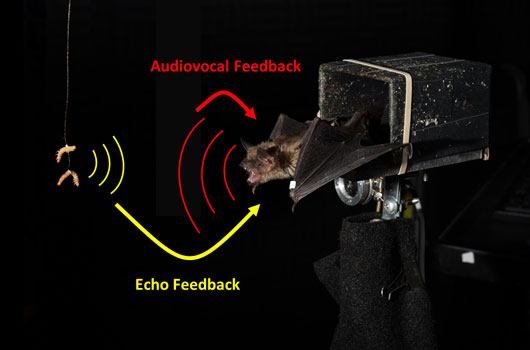How do we analyze and update the speech sounds we produce? Why do professional singers typically wear an earphone during performances? And why do individuals speak with local dialects? Answers to these questions can be understood through a general auditory process: audiovocal feedback. We are unconsciously monitoring our own vocalizations as we talk or sing and make changes to the spectral characteristics of the sounds we produce as vocal feedback changes. By contrast, decades of research have established the textbook view that echolocating animals rely on echo returns, or echo feedback (see figure), to adapt their echolocation call structure. Here, we demonstrate that echolocating bats rely on vocal feedback, and not echo feedback, to adapt their sonar call design in response to acoustic jamming signals.

Figure: Illustration of two auditory processes in echolocation. Audiovocal feedback is the auditory process of listening to one’s own vocalization during sound production. Echo feedback refers to the process of listening to sonar returns from objects in the environment.
In this study, we exploited a novel behavioral paradigm in which the echolocating big brown bat was trained to rest on a platform and to track an approaching tethered insect by echolocation. Since the insect target trajectory is under precise computer control, we can unambiguously separate the audiovocal feedback process from echo feedback process. Combined with an analog triggering technique and customized computer programs, we were able to deliver acoustic jamming signals at experimentally timed delays greater than about 0.6 ms relative to the sonar call onset. Thus, we can selectively perturb either audiovocal feedback or echo feedback. Two key findings emerged. First, echolocating bats adjust the frequency of echolocation signals in response to acoustic jamming signals that occur during vocal production, not echo reception, providing the first evidence that vocal feedback is directly involved in the bat’s adaptive sonar call design. Second, bats adapted the sonar call design in the first call after the jamming signals, revealing a response latency of 66~94 ms, which is much faster than our present knowledge (100~150 ms in humans).
Our findings impact the textbook view of echolocation by demonstrating that echolocation not only involves echo processing, but also sonar call processing. Moreover, the functional role of audiovocal feedback in echolocation directly links echolocating animals with humans, songbirds and other species that rely on audiovocal feedback to guide the production of acoustic communication signals.
Reference
Echolocating bats rely on audiovocal feedback to adapt sonar signal design. Jinhong Luo, Cynthia F. Moss. 2017. Proceedings of the National Academy of Sciences. doi: 10.1073/pnas.1711892114; PNAS September 25, 2017
Related articles on the HFSP website
Bats rapidly turn up the volume of their vocalizations in noisy environments


































